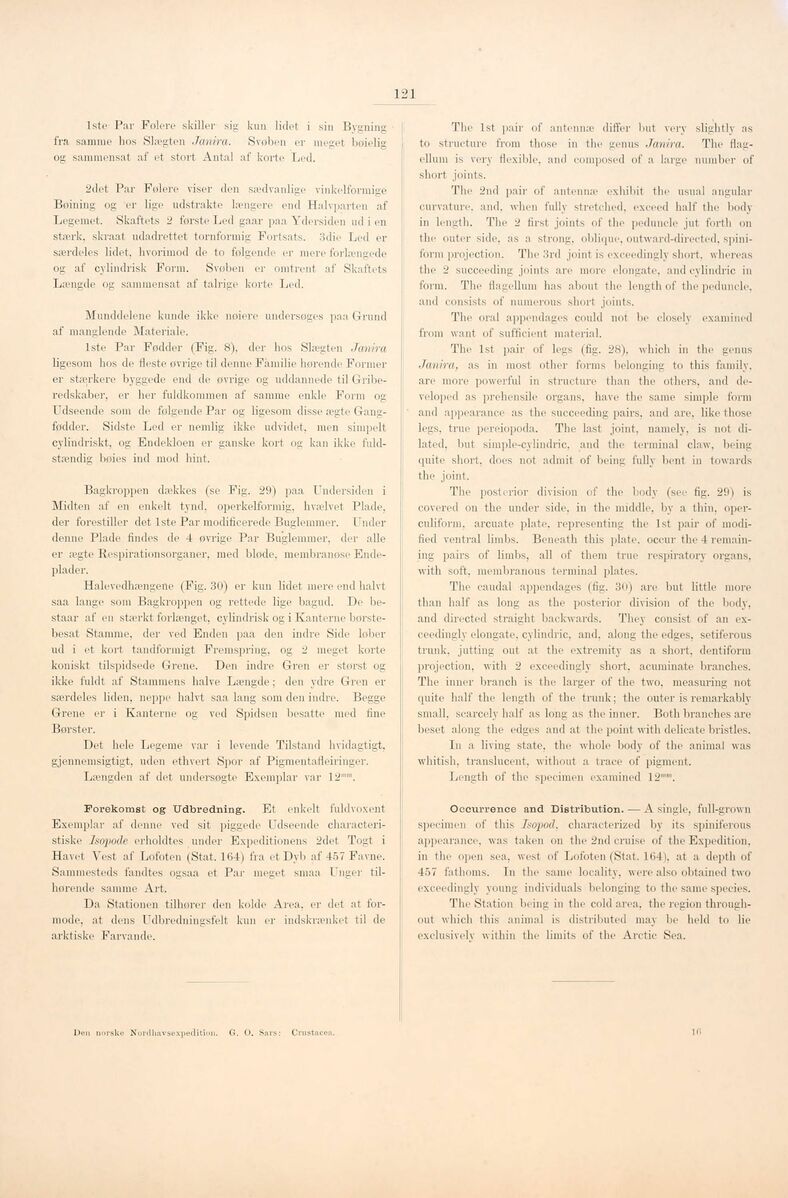
Full resolution (JPEG) - On this page / på denna sida - Sidor ...

<< prev. page << föreg. sida << >> nästa sida >> next page >>
Below is the raw OCR text
from the above scanned image.
Do you see an error? Proofread the page now!
Här nedan syns maskintolkade texten från faksimilbilden ovan.
Ser du något fel? Korrekturläs sidan nu!
This page has never been proofread. / Denna sida har aldrig korrekturlästs.
121
lstc Par Folere skiller sig kun lidet i sin Bygning
fra samme hos Slægten Janira. Svøben er meget boielig
og sammensat af et stort Antal af korte Led.
2det Par Følere viser den sædvanlige vinkelformige
Bøining og er lige udstrakte længere end Halvparten af
Legemet. Skaftets 2 förste Led gaar paa Ydersiden ud i en
stærk, skraat udadrettet tornfonnig Fortsats. 3die Led er
særdeles lidet, hvorimod de to følgende er mere forlængede
og af cylindrisk Form. Svøben er omtrent af Skaftets
Længde og sammensat af talrige korte Led.
Munddelene kunde ikke nøiere undersøges paa Grund
af manglende Materiale.
1ste Par Fødder (Fig. 8), der hos Slægten Janira
ligesom hos de fleste øvrige til denne Familie hørende Former
er stærkere byggede end de øvrige og uddannede til
Griberedskaber, er her fuldkommen af samme enkle Form og
Udseende som de følgende Par og ligesom disse ægte
Gang-fødder. Sidste Led er nemlig ikke udvidet, men simpelt
cylindriskt, og Endekloen er ganske kort og kan ikke
fuldstændig bøies ind mod hint.
Bagkroppen dækkes (se Fig. 29) paa Undersiden i
Midten af en enkelt tynd, operkelformig, hvælvet Plade,
der forestiller det 1ste Par modificerede Buglemmer. Under
denne Plade findes de 4 øvrige Par Buglemmer, der alle
er ægte Bespirationsorganer, med bløde, membranøse
Ende-plader.
Halevedhængene (Fig. 30) er kun lidet niere end halvt
saa lange som Bagkroppen og rettede lige bagud. De
bestaar af en stærkt forlænget, cylindrisk og i Kanterne
børstebesat Stamme, der ved Enden paa den indre Side lober
ud i et kort tandformigt Fremspring, og 2 meget korte
koniskt tilspidsede Grene. Den indre Gren er størst og
ikke fuldt af Stammens halve Længde; den ydre Gren er
særdeles liden, neppe halvt saa lang som den indre. Begge
Grene er i Kanterne og ved Spidsen besatte med tine
Børster.
Det hele Legeme var i levende Tilstand hvidagtigt,
gjennemsigtigt, uden ethvert Spor af Pigmentafleiringer.
Længden af det undersøgte Exemplar var 12""".
Forekomst og Udbredning. Et enkelt fuldvoxent
Exemplar af denne ved sit piggede Udseende
cliaraeteristiske Isopode erholdtes under Expeditionen 2det Togt i
Havet Vest af Lofoten (Ståt. 164) fra et Dyb af 457 Favne.
Sammesteds fandtes ogsaa et Par meget smaa Unger
tilhorende samme Art.
Da Stationen tilhorer den kolde Area, er det at
formode, at dens Ddbredningsfelt kun er indskrænket til de
arktiske Farvande.
The lst pair of antennæ differ but very slightly as
to structure from those in the genus Janira. The
flag-ellum is very flexible, and composed of a large number of
short joints.
The 2nd pair of antennæ exhibit the usual angular
curvature, and. when fully stretched, exceed half the body
in length. The 2 first joints of the peduncle jut forth on
the outer side, as a strong, oblique, outward-directed,
spini-forin projection. The 3rd joint is exceedingly short, whereas
the 2 succeeding joints are more elongate, and cylindric in
form. The flagellum has about the length of the peduncle,
and consists of numerous short joints.
The oral appendages could not be closely examined
from want of sufficient material.
The 1st pair of legs (fig. 28), which in the genus
Janira, as in most other forms belonging to this family,
are more powerful in structure than the others, and
developed as prehensile organs, have the same shnple form
and appearance as the succeeding pairs, and are, like those
legs, true pereiopoda. The last joint, namely, is not
dilated, but simple-cylindric, and the terminal claw, being
quite short, does not admit of being fully bent in towards
the joint.
The posterior division of the body (see fig. 29) is
covered on the under side, in the middle, by a thin,
oper-culiform, arcuate plate, representing the 1st pair of
modified ventral limbs. Beneath this plate, occur the 4
remaining pairs of limbs, all of them true respiratory organs,
with soft, membranous terminal plates.
The caudal appendages (fig. 30) are but little more
than half as long as the posterior division of the body,
and directed straight backwards. They consist of an
exceedingly elongate, cylindric, and, along the edges, setiferous
trunk, jutting out at the extremity as a short, dentiform
projection, with 2 exceedingly short, acuminate branches.
The inner branch is the larger of the two, measuring not
quite half the length of the trunk; the outer is remarkably
small, scarcely half as long as the inner. Both branches are
beset along the edges and at the point with delicate bristles.
In a living state, the whole body of the animal was
whitish, translucent, without a trace of pigment.
Length of the specimen examined 12""".
Occurrence and Distribution. — A single, full-grown
specimen of this Isopod, characterized by its spiniferous
appearance, was taken on the 2nd cruise of the Expedition,
in the open sea, west of Lofoten (Ståt. 164), at a depth of
457 fathoms. In the same locality, were also obtained two
exceedingly young individuals belonging to the same species.
The Station being ill the cold area, the region
throughout which this animal is distributed may be held to lie
exclusively within the limits of the Arctic Sea.
Den norske Nordliavsexpeditinii. G. O. Sars: Crustacea.
<< prev. page << föreg. sida << >> nästa sida >> next page >>